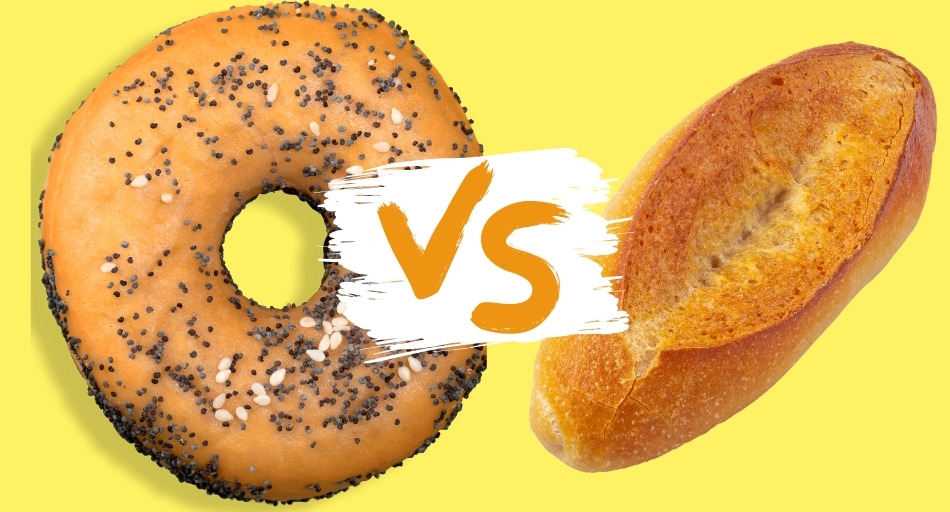Bread and bagels are both a common breakfast food around the world. While they’re both baked goods made with flour, there are a lot of nutritional differences between them.

This often makes people wonder which one of them is healthier, especially as bagels are getting a lot of attention these days.
So, are bagels healthier than bread? Which one is better to consume?
Table of Contents
Are bagels healthier than bread?
Whether bread or bagels are healthier depends on the type and how much you eat. For example, whole wheat bagels and bread provide you with more minerals and vitamins than the kinds made with white refined flour.
In the same way, make sure to keep in mind that a single slice of bread is lower in calories than one bagel. So, whether one is healthier than the other depends strongly on your nutritional requirements and dietary goals.
Is bread worse for you than bagels?
Firstly, it all depends on whether your goal is weight loss. If it is, then you’re better off eating a slice of bread, preferably whole grain or whole wheat.
This is because one slice of whole wheat bread provides you with about 70 calories, while a bagel can have up to 300 calories in a single serving – and that doesn’t include toppings.
So, as you can see, you’d have to eat almost four slices of bread to get the same number of calories from bread as from a single bagel.

Plain, white bagels and bread also have similar nutritional profiles per calorie. They contain some thiamin, iron, manganese, and niacin, but these amounts are rather small.
Because of that, even though bagels have more calories, they provide you with more vitamins and minerals per single serving as they’re larger.
Additionally, bagels tend to be topped with more caloric foods, such as cream cheese. This can increase the calories, even more, making it hard to lose weight if that’s your goal.
Again, if you’re trying to lose weight, choosing whole grain bread might be better than sticking with bagels.
This is because a single slice of whole-grain bread provides you with 1.6 g of fiber and only around 70 calories.
On the other hand, one bagel has around 280 calories and 1.9 g of fiber. While still being very low in calories, whole grain bread provides you with an excellent amount of manganese, selenium, phosphorus, folate, and thiamin.
Bagels still do contain these nutrients, but it comes with a cost of many calories.
If you’re not aiming at weight loss, both bread and bagels have their upsides and downsides. If you choose whole grain, oat bran, whole wheat, or egg bagels, you’re getting more protein, fiber, and micronutrients than you would have from a single slice of white bread.

So, if you’re OK with consuming slightly more calories, it might be a good idea to choose these varieties of bagels and top them with some smoked salmon and fresh veggies.
This will further up your intake of nutrients, contributing to good health.
Are bagels good for you?
Most types of bagels are a great source of fiber, but whole wheat in particular. One whole-wheat bagel contains around 7.4 g of fiber, which is a lot for such a serving.
Fiber helps you feel full after eating, aiding in weight loss and weight management. A diet rich in foods high in fiber can also help you keep your blood sugar levels in check and reduce the symptoms of acid reflux.
So, having an occasional bagel topped with some healthy veggies and fat sources can help you reap these benefits.
Whole wheat bagels are also rich in iron, a micronutrient important for the production of hemoglobin, which is found in red blood cells. Iron also helps control the temperature of your body, manage energy levels, and boost the immune system.
One whole wheat and whole-grain bagel can provide you with as much as 15% of your need for this nutrient per day.
So, if you top your bagel with some spinach or avocado, you can get even more iron from your meal.

One of the downsides to bagels is that most of them are usually loaded with sodium. While it’s important to get this mineral from a healthy, balanced diet, too many high-sodium foods can negatively impact your health.
High-sodium foods have been linked to high blood pressure, increased risk of strokes, and higher chances of heart attacks.
One bagel can provide you with as much as 431 mg of sodium. So make sure to either consume smaller portions or limit how often you have bagels altogether, especially if you’re prone to high blood pressure.
What types of bagels are the healthiest?
Just like with bread, it’s best to go for whole wheat or whole-grain bagels to create the healthiest meal.
This helps ensure that you’re getting the most nutrients out of your bagel. Whole wheat bagels are rich in iron and calcium as well as contain nearly 30% of your daily recommended need for fiber.
As a result, eating this type of bagel can even be beneficial for people trying to lose weight in a healthy way.

Also, try skipping cream cheese and replacing it with raw cheese like gouda or mozzarella, and add veggies, including tomatoes, cucumbers, and even leafy greens.
These can help you increase how much fiber you’re consuming while adding other essential vitamins and minerals as well as antioxidants.
These compounds help flush our free radicals from your body, preventing chronic inflammation, heart disease, diabetes, and even cancer. So, adding veggies to any meal is a great idea, especially bagels.
Conclusion
As you can see, bagels have similar nutritional profiles per calorie. But one is usually served in bigger servings – bagel – while the other in much smaller ones – bread.
So, make sure to keep that in mind before choosing which one you eat.
Additionally, try sticking to whole grain or whole wheat bread and bagels to ensure that you’re getting the most out of your meal in terms of nutrients.
